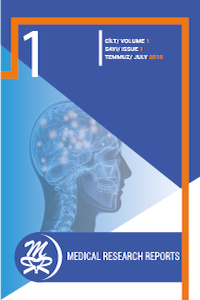Bir Üniversite Hastanesi Çocuk Acil Polikliniğine Başvuran 3-6 Yaş Arası Çocuklarda Tam İdrar Tetkiki ile İdrar Kültürü Bulguları Arasındaki İlişki
idrar yolu enfeksiyonu, lökosit esteraz, nitrit, tam idrar tetkiki
The Association Between Urinalysis and Urine Culture Results in Children Aged 3-6 Years Who Applied to A Pediatric Emergency Clinic at A University Hospital
urinary tract infections, leukocyte esterase, nitrite, urinalysis,
___
- Ishrat NN, Rezwanul AM, Farhana J, Nahar FN. Clinical and Laboratory Profile of Childhood Urinary Tract Infection in a Tertiary Care Hospital of Bangladesh. CODHR-V7 [Internet]. 2023 Feb. 3 [cited 2023 Feb. 27];46-63. Available from: https://stm.bookpi.org/CODHR-V7/article/view/9430
- Bagga A. Urinary tract infections: evaluation and treatment. Indian journal of pediatrics. 2001;68:S40-5. White B. Diagnosis and treatment of urinary tract infections in children. Am Fam Physician. 2011;83(4):409-415.
- Tekin M, Konca C, Almis H, Bucak IH, Genc Y, Gunduz A, et al. Cocukluk cagi idrar yolu enfeksiyonu tanisinda tam idrar tetkikinin tanısal etkinliginin irdelenmesi. Journal of Dr Behcet Uz Children's Hospital. 2015;5(2).
- Mattoo TK, Shaikh N, Nelson CP. Contemporary management of urinary tract infection in children. Pediatrics. 2021;147(2).
- Swetha M, Ravindranath C, Divya H. Antimicrobial susceptibility pattern in Escherichia coli causing urinary tract infection among children. International Journal of Medical Reviews and Case Reports. 2023;6(18):69-.
- Leung AK, Wong AH, Leung AA, Hon KL. Urinary tract infection in children. Recent patents on inflammation & allergy drug discovery. 2019;13(1):2-18.
- Shaikh N, Shope TR, Hoberman A, Vigliotti A, Kurs-Lasky M, Martin JM. Association between uropathogen and pyuria. Pediatrics. 2016;138(1).
- Nyayadhish R, Mishra K, Kumar M, Saigal K. Identification of Probable Urinary Tract Infection in Children Using Low Bacterial Count Thresholds in Urine Culture. Indian Pediatrics. 2023:S097475591600488-S.
- Pouladfar G, Basiratnia M, Anvarinejad M, Abbasi P, Amirmoezi F, Zare S. The antibiotic susceptibility patterns of uropathogens among children with urinary tract infection in Shiraz. Medicine. 2017;96(37).
- National Institute for Health and Clinical Excellence (NICE). Urinary tract infection in children. Available at: https://www.nice.org.uk/Guidance/cg54 [Last Accessed 23 February 2023].
- Downing H, Thomas-Jones E, Gal M, Waldron C-A, Sterne J, Hollingworth W, et al. The diagnosis of urinary tract infections in young children (DUTY): protocol for a diagnostic and prospective observational study to derive and validate a clinical algorithm for the diagnosis of UTI in children presenting to primary care with an acute illness. BMC infectious diseases. 2012;12(1):1-15.
- Alper BS, Curry SH. Urinary tract infection in children. American Family Physician. 2005;72(12):2483-8.
- Ipekci T, Celik O, Aydogdu O, Akand M, Yuksel MB. Uriner sistem enfeksiyonlarina guncel yaklasim. The Cystoscope. 2014;1:73-81.
- Zorc JJ, Kiddoo DA, Shaw KN. Diagnosis and management of pediatric urinary tract infections. Clinical microbiology reviews. 2005;18(2):417-22.
- Lee SP, Vasilopoulos T, Gallagher TJ. Sensitivity and specificity of urinalysis samples in critically ill patients. Anaesthesiology Intensive Therapy. 2017;49(3):204-9.
- Gulcan A, Celik G, Gulcan E, Cansever Z, Aladag DM. Idrar yolu enfeksiyonu supheli hastalarda tam idrar analizi ve kultur sonuclarinin performans degerlendirmesi. Abant Tip Dergisi. 2012;1(2):61-4.
- Hay AD, Sterne JA, Hood K, Little P, Delaney B, Hollingworth W, et al. Improving the diagnosis and treatment of urinary tract infection in young children in primary care: results from the DUTY prospective diagnostic cohort study. The Annals of Family Medicine. 2016;14(4):325-36.
- Bodur S, Filiz E. 7-12 yas cocuklarda piyüri sikliginin demografik ozellikler, gecirilmis uriner enfeksiyon ve okul tuvaletini kullanma ile iliskisi. Genel Tip Dergisi. 2011;21(2)
- Ercan S, Yucel N, Ozer RS, Orcun AK. Yas ve Cinsiyete Gore Idrar Nitrit ve Lokosit Esterazİn Tanİ Performanslari. Turk Klinik Biyokimya Dergisi. 2014;12(2):91-8.
- Unal B, Delibas A, Kuyucu N. Odagi Belli Olmayan Dusuk Riskli Atesli Cocuklarda Idrar Yolu Enfeksiyonu Sikliği ve Belirlemede Cesitli Idrar Inceleme Yontemlerinin Karsilastirilmasi. Journal of Pediatric Infection/Cocuk Enfeksiyon Dergisi. 2011;5(2).
- Yang SS, Tsai J-D, Kanematsu A, Han C-H. Asian guidelines for urinary tract infection in children. Journal of Infection and Chemotherapy. 2021;27(11):1543-54.
- Yayın Aralığı: Yılda 3 Sayı
- Başlangıç: 2017
- Yayıncı: M. Tayyib KADAK
Büyük Verteks Ekstradural Hematomun Konservatif Yönetimi: Bir Olgu Sunumu
Bekir TUNÇ, Emin ÇAĞIL, Goksal GUNERHAN, Egemen IŞITAN
Polikistik Over Sendromlu (PKOS) Kadınlarda Anormal MiRNA Ekspresyonu
Sude TOPKARAOĞLU, Gulam HEKİMOĞLU
Adölesanlarda Teknoloji Bağımlılığı
Ahmet TİMUR, Salih METİN, Betül BAKIŞ
Funda EKİMCİ DENİZ, Ayfer GEMALMAZ
TÜRKİYE’DEN GERİ ÇEKİLEN BİLİMSEL YAYINLARIN İNCELENMESİ
Fahad AHMED, Yazgı Beriy ALTUN GÜZELDEREN, Şefik YURDAKUL, Parısa POURALI KAHRIZ, Khalıd Mahmood KHAWAR
Klinik ve Radyolojik Bulgularla Trigeminal Nevralji: 3 Olgu Sunumu
